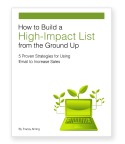Content Marketing Made Easier
By backing off from the urge to sell, sell, sell, and instead focusing on educating and providing valuable information on a consistent basis, astute marketers are finding themselves rewarded with both loyal customers and increased sales.
Let’s face it. People are becoming more and more immune to traditional marketing tactics by the second. And as consumers become more savvy, they increasingly resist being sold to, preferring instead to be engaged.
Just check out these statistics from Roper Public Affairs:
- 80% of business decision makers prefer getting information from a company in a series of articles rather than as an advertisement.
- 70% say content marketing makes them feel closer to the sponsoring company.
- 60% say content marketing helps them make better product decisions.
But take heart.
You don’t have to start from scratch. In fact, there are many ways to transform what you already have into masterpieces of content.
Repurpose interviews
Know someone at your organization who’s about to be or has recently been interviewed? Whether conducted by someone in the media or someone internal to your business, an interview can be a gold mine of content.
For example, try capturing the interview as either a video or audio presentation—or both.
Video alone can be repurposed in a multitude of ways, from being broadcast on video sharing sites like YouTube to becoming the latest addition to your company website.
You could also repackage the interview as a free DVD to be handed out at trade shows or offered through your website or as part of a direct mail campaign.
Audio recordings can be added to your site as a podcast or uploaded to a podcast directory such as iTunes.
And transcripts of the interview can be reformatted as articles for trade publications, added to newsletters, or even shared as a series of tweets.
Repurpose newsletters
Have some old company newsletters lying around? Newsletter articles can be revamped as blog posts, posted to article directories, or combined to create free white papers or ebooks.
Even the simple act of archiving past issues on your website will result in increased SEO rankings—which translates into more visitors to your site.
Repurpose internal documents
If your company is large enough, chances are you provide new and existing employees with various manuals designed to acquaint them with your organization’s history, culture, processes, and rules.
And you probably also use departmental memos or newsletters to keep employees in the loop and make them feel they’re part of a team.
This feeling of being a part of something is also an integral component of any effective content strategy, because content marketing attempts not only to educate existing and potential buyers, but to tell the story of the motivations, beliefs, and values of the company itself.
Take Apple, for example. Steve Jobs built his empire by targeting people who considered themselves creative, forward thinking, and independent.
And Apple’s corporate image has always reflected that strategy—presenting the company as the hip, cutting edge alternative to the conservative, unimaginative PC.
By transforming everything from corporate memos to training manuals, you can give your prospects an insider’s view of who you really are—an openness that translates into loyalty, respect, and sometimes even a rabid following.
Making the move to the marketing of content—instead of just marketing—really is a common sense strategy every marketer should be using. And because of its focus on value, education, and respect for the consumer, it’s an approach tailor made for the environmental and green market.
So whether you’re just getting started on a content strategy or are thinking about expanding or updating the one you already have, take some time to sift through your old materials. You could have a wellspring of value just waiting to be tapped.
Return to articles




